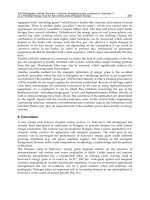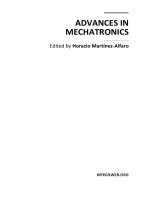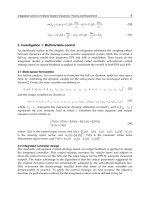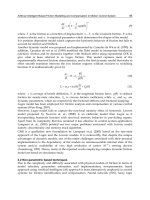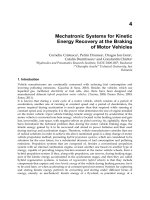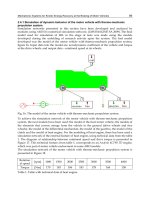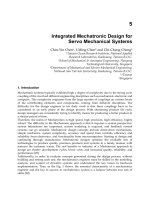Advances in Mechatronics Part 16 docx
Bạn đang xem bản rút gọn của tài liệu. Xem và tải ngay bản đầy đủ của tài liệu tại đây (183.42 KB, 12 trang )
Transdisciplinary Approach of the Mechatronics in the Knowledge Based Society
289
Only the transdisciplinary knowledge achievement, as a new methodology, can explain the
way the creativity, with a synergistic signification, works as an intentional action through
ideas, design, modelling, prototyping, simulation, incorporating informergically the inform-
action in matt-ergy, to realize smart products, sustainable technologies and specific
integrative methods to give solution to the emerging problems. Real experiences cannot be
replaced by learning only with simulations, for this being necessary to use complementarily,
the virtual tools as design, modelling, simulation and the real world representations as
prototyping, building smart mechatronical products, technologies and systems.
The proposed integrative model demonstrates that mechatronics cannot be considered as
multi(pluri)disciplinary, inter(cross)disciplinary, nor a simple new discipline, neither a
simple methodology, but a transdisciplinary approach of the mechatronical knowledge in
the informergical society (informergy is informaction incorporated intelligently in
mattergy), as is sustained through the semiophysical communicational contextual message
model, with the “What-How-Why” questioning paradigm (
24
) of the mechatronics. The
transdisciplinary knowledge integrative mechatronical model, with the five stages of the
evolution of the knowledge process from monodisciplinarity to transdisciplinarity, through
codisciplinarity, multi(pluri)disciplinarity and inter(cross)disciplinarity, is considered more
integrative then the educational mechatronical model, integrating the transthematic aspect
of the mecahatronics, with representative selection, interactive communication and
functional legitimacy aspects (mechatronical epistemology), as a reflexive way of
communication through design, modeling (the creative logic of the included middle) and a
socio-interactive system of thinking, living and acting (mechatronical ontology).
The most important thing is to know what mechatronics is, what isn’t and how does it work,
mechatronics being not a simple discipline, but working through the new transdisciplinary
transthematic educational paradigm by its exemplifying selection (what), interactive
communication (how) and functional contextual legitimation (why) aspects.
Mechatronics can be considered as a synergistic integrative system of Scientia, as a new
educational transdisciplinary paradigm (mechatronical epistemology), of Techne, working
as a reflexive way of the integrative design (the creative logic of the included middle) and,
as Praxis, through a new socio-interactive system of thought, living and action
(mechatronical ontology)
About the future of integrative mechatronics, the transdisciplinary approach opens new
perspectives on its development, incorporating more and more ideas which will be
accounted to improve the way to do things and to live in the new context of ever-changing
needs and willings of a complex and complicated world, when innovations and
technologies have to be improved and developed with the rapidly changing times. The
postepistemic economy will integrate in a synergistic-generative way the technical
dimension with epistemic and with socioeconomical dimension, resulting the
metamechatronics as a transdisciplinary engineering mecha-system (
25
).
4. Notes
1
Synergy, synergistic signification is the transdisciplinary semiophysical process by which a
system generates emergent properties resulting in the condition in which a system may be
considered more then the sum of its parts (equal to the sum of its parts and their
relationships) (synergy, 1 + 1 > 2, more then everyone, and signification, 1 - 1 ≠ 0, otherwise
then everyone) (Tähemaa, 2004; Bolton, 2006; Pop & Vereş, 2010).
Advances in Mechatronics
290
2
Agents are considered to be the ocupants of a knowledge system field (a semophysical
system working through spatial participative sequence - space wise, temporal-connective
sequence – time wise, actional – interactive sequence – act wise) (Pop, 1980);
3
This a contextual adaptation of the apo-kataphatic approach of knowledge which does
explain through the interparadigmatic dialogue the japanese roots of the mechatronics
(Mushakoji, 1988).
4
Principle of included middle (tertium quid) is the natural law by which triple is produced
out of couple, rejecting the claim that the the mind (consciousness) and the body (object) are
separated. Is proposed a change to the third classical linear logic axiom, submitting that a
third term T does exist, being simultaneously A and non-A. Only considering this third term
T, problem solvers would be able to integrate perspectives from different realities
(economics with environmental), let alone integrate Subject (consciousness and perceptions)
with Object (information) (Nicolescu, 2011).
5
Smart mechatronical products, technologies and systems are considered sustainable if they
are incorporating transdisciplinarily the informaction (information in action) in mattergy
(matter and energy), with a high level of reciclable matter and low level of incorporated
energy, in a modular configurational design, with a creative and responsible stewardship of
resources in order to generate stakeholder value contributing to the well-being of current
and future generations (Rzevski, 1995; Montaud, 2008).
6
Paradigm is a set of fundamental beliefs, axioms, and assumptions that order and provide
coherence to our perception of what is and how it works (a basic world view, also example
cases and metaphors), refering to a thought pattern in any scientific discipline or other
epistemological context, with theories, laws, generalizations and the experiments performed
(broadly, a philosophical or theoretical framework of any kind) (Pop & Vereş, 2010 );
7
Mechatronician is a multi-skilled specialist, as engineer, technician, worker, envolved in
the mechatronical design, creation and maintainance of smart products, technologies,
systems (Rainey, 2002);
8
The multi(pluri)disciplinary approache juxtaposes disciplinary/professional perspectives,
adding breadth and available knowledge, information, and methods, speaking as separate
voices; such activities involve researchers from various disciplines working essentially
independently, each from own discipline specific perspective, to address a common
problem; even multi(pluri)disciplinary teams do cross discipline boundaries; however, they
remain limited to the framework of disciplinary research; Multidisciplinarity – a
relationship between related disciplines occurring simultaneously without making explicit
possible relationships or cooperation between them, working at methodological level of the
integrative process of knowledge; Pluridisciplinarity – a relationship between various
disciplines grouped in such a way as to enhance the cooperative relationships between
them, working at the methodological level of the integrative process of knowledge (Pop &
Mătieş, 2008);
9
Inter(cross)disciplinarity is working on unity of knowledge differing from a complex,
dynamic web or system of relations, but without producing a combination or synthesis
which would go beyond disciplinary boundaries, for innovative solutions to knowledge
questions, remaining in the disciplinary bounderies. Interdisciplinarity is a structural
synergistic approach for a group of related disciplines having a set of common purposes and
coordinated from a higher purposive level, that integrates separate disciplinary data,
methods, tools, concepts, and theories in order to create a holistic view, or common
understanding of complex issues, questions, or problem. Crossdisciplinarity is a functional
Transdisciplinary Approach of the Mechatronics in the Knowledge Based Society
291
synergistic approach for various disciplines where the concepts or goals of one are imposed
upon other disciplines, thereby creating a rigid control from one disciplinary goal (Habib,
2008, Pop & Mătieş, 2009, Fuller, 2001).
10
Transdisciplinarity concerns with that is at once between the disciplines, across the
different disciplines, and beyond all disciplines, connecting what is known (theory - what)
to action (application - how), in order to accomplish specific goals in the context of human
survival, sustainability and creativity (worldly problems and/or opportunities), creating
new knowledge, new languages, new disciplines, new systems, new processes and new
economic opportunities. Transdisciplinary approaches are comprehensive frameworks that
transcend the narrow scope of disciplinary world views through an overarching synergistic
generative sinthesis of knowledge, including cooperation within the scientific community
with a permanent debate between research and the society at large, transgressing
boundaries between scientific disciplines and between science and other societal fields, with
deliberation about facts, practices and values, at the stages of conceptualization, design,
analysis, and interpretation by integrated team approaches, realizing the coordination of
disciplines and interdisciplines with a set of common goals towards a common system
purpose (Jantsch, 1972; Nicolescu, 1996; Max Neef, 2005).Transdisciplinary methodology is
working with three axioms, the ontological axiom (there are different levels of Reality of the
Object and, correspondingly, different levels of Reality of the Subject); the logical axiom (the
passage from one level of Reality to another is insured by the logic of the included middle)
and the epistemological axiom (the structure of the totality of levels of Reality has a complex
structure, every level being what it is because all the levels exist at the same time)
(Nicolescu, 1996).
11
Predisciplinarity stage is the first step of the lowest level, the thematic-curricular level of
the integration knowledge process, the way a discipline is born; disciplinarity context is the
classical mode of deapth approach of knowledge with own boundaries, methodologies, and
specific content; codisciplinary context of the integration of knowledge is conecting, from a
transdisciplinary point of view, the three levels, the thematic-curricular, the methodological
level and the synergistic one (Pop & Mătieş, 2008).
12
Communities of practice (CoPs), as knowledge achievement environments, are functioning
as creative group of people who share an interest, a craft, and/or a profession, evolving
naturally because of the common interst of the members in a particular domain or area, or it
can be created specifically with the goal of gaining knowledge related to their field (Wenger
& Snyder, 2000).
13
Organisational educational environment is working with the principles of mechatronical
education which can be applied successfully to all teaching levels, creating the necessary
teaching-learning environment, as a teaching factory, as a mobile mechatronical platform, or
as another specific educational systems (Nonaka & Takeuchi, 1994; Lamancusa et al, 1997;
Doppelt & Schunn, 2008; Mătieş, 2009).
14
Cognitive way of knowledge does explain the way stimuli (coming from the sensitive
sensors, as a bottom up approach) and signals (at the brain level, as a top down approach)
are working together in the ART (Adaptive Resonant Theory) (Grossberg, 1995);
15
Creative innovative context is determined by the learning/teaching transdisciplinary
environment, as teaching factory through all life learning aspects (lifewide learning, longlife
learning and learning for life), that challenges perspective of the learners and facilitates the
expansion of their worldview, promoting human fulfillment, enabling the learners to cope
with uncertainty and complexity, empowering them to shape creatively change in order to
Advances in Mechatronics
292
configurate the future through the synergistic design (Lamancusa et al, 1997;Alptekin, 2001;
Erdener, 2003; Habib, 2008).
16
Transdisciplinary semiophysical contextual message model is working with 7 questions:
where (space wise sequence), when (time wise sequence), who, with whom, what, how and
why (act wise sequence) (Bradley, 1997; Harashima et al, 1996; Buckley, 2000; Pop & Vereş,
2010).
17
Knowledge search window is a methodological concept explaining the bottom-up/top-
down mechanism of the teaching-learning process in the mechatronical educational
paradigm using the included middle transdisciplinary perspective (Lupasco, 1987, Pop,
2009);
18
Conceptual space presuposes to identify, to develop and to evaluate the creativity working
in such a way to realise the equillibrium between tradition and innovation, the most creative
individuals being considered those who explore a conceptual structure going beyond them
in a transdisciplinary way, managing the reconfiguration of the new structures to achieve
knowledge which transgress the barriers, bridging the gaps and filling the fields (Boden,
1994; Schafer, 1996;De Vries, 1996; Doppelt & Schunn, 2008).
19
Boundaries are parametric conditions that are delimiting and defining a system, and set it
apart from its environment;
20
Mechatronics works as an opening new transthematic generative discipline, with a very
transdisciplinary character, bridging the gaps between different disciplines, as a step by step
way through codisciplinary connection, multi(pluri)disciplinary combination,
inter(cross)disciplinary overlap, and transdisciplinary synergistic synthesis (Pop & Vereş,
2010);
21
Codisciplinary outer nodal points are considered as resource springs generating
mechatronical knowledge, expressed as a synergy between mechatronical transdisciplinary
education, mechatronical design as a reflexive creative language and the mechatronical
intelligent systems, technologies and products (Pop & Mătieş, 2008);
22
Sustainability represents the creative and responsible stewardship of resources (human,
natural and financial resources management) in order to generate stakeholder value while
contributing to the well-being of current and future generations of all beings. Sustainable
development is an individual, societal, or global process, which can be said to be sustainable
(sociocultural, economical, educational, technological, and ecological as well) if it involves
an adaptive strategy that ensures the evolutionary maintenance of an increasingly robust
and supportive specific environment, such a process enhancing the possibility to generate a
wellfaire state (Giovannini & Revéret, 1998);
23
Multiple transdisciplinary paradigm represents the informergically integration
(informaction integrated in mattergy) of the creativity (adequateness and innovation) in
action (competition and performance) and authenticity (character and competence) through
participation (apprenticeship in communion) (Pop & Mătieş, 2009).
24
The “What-How-Why” questioning paradigm is a transdisciplinary knowledge integrative
mechatronical model, integrating the transthematic aspect of the mecahatronics, with
representative selection, interactive communication and functional legitimacy aspects
(mechatronical epistemology), as a reflexive way of communication through design,
modeling (the creative logic of the included middle) and a socio-interactive system of
thinking, living and acting (mechatronical ontology) (Pop & Vereş, 2010).
25
Meta-mechatronics is a transdisciplinary engineering mecha-system, resulting through
synergistic synthesis of the Scientia (Educational Mechatronics), Techne (Technological
Transdisciplinary Approach of the Mechatronics in the Knowledge Based Society
293
Mechatronics), and Praxis (Economical Mechatronics) at the top level of integration as
informergical metamodel (Hug et al, 2009; Pop & Vereş, 2010).
5. References
Alptekin, S.E., (1996), Preparing the Leaders for Mechatronics Education, FIE '96, 26th
Annual Conference, Proceedings of the Frontiers in Education Conference, Vol. 2, 6-9
Nov. 1996, pp. 975–979.
Altshuller, G., Zlotin, B., Zusman, A. & Filatov, V., (1989), Search for New Ideas: from Insight to
Technology, Kartia Moldavenayska, Kishenev.
Arkin, R., Lee, K-M., McGinnis, L., & C. Zhou (1997),The Development of a Shared
Interdisciplinary Intelligent Mechatronics Laboratory, Journal of Engineering
Education. April, pp.113-118.
Arnold, S. (2008), Thesis, Transforming systems engineering principles into integrated project team
practice, Cranfield University.
Arecchi, F.T., (2007), Physics of cognition: Complexity and creativity, European. Phys. Journal,
Special Topics, Vol. 146, pp. 205–216.
Ashley, S., (ass. ed.), (1997), Getting a hold on mechatronics, , Mechanical Engineering-CIME,
May, vol. 1. A.
Auslander, D.M. (1996), What is mechatronics? IEEE/ASME Transactions on Mechatronics,
Vol.1.No. 1, pp. 5-9.
Barak, M., & Doppelt, Y. (1998). Promoting creative thinking within technology education.
International Workshop for Scholars in Technology Education, WOCATE, George
Washington University, Washington, DC.
Baritz M., Cotoros D., Repanovici A. & Rogozea L., (2010), Cognitive Virtual Learning Used
for Improving the Long Term Handling Skills, Proceedings of the 6th WSEAS/IASME
International Conference on EDUCATIONAL TECHNOLOGIES (EDUTE'10), Tunisia,.
Barret, T., ed. (2005), “Understanding Problem-Based Learning”, in Handbook of Enquiry &
PBL.
Berte, M. (2003), Active learning and transdisciplinarity, Cluj-Napoca: Promedia Plus Press.
Berte, M., (2005), Transdisciplinarity and Education: “The treasure within” -Towards a
transdisciplinary evolution of education, The 2nd World Congress of
Transdisciplinarity, Brazil.
Berian, S., (2010), Thesis, Research about the transdisciplinary potential of the Mechatronics (Teză
de doctorat, Cercetări privind potenţialul transdisciplinar al mecatronicii), Universitatea
Tehnică Cluj-Napoca.
Bishop, H.B. & Ramasubramanian, M.K., (2002), What is Mechatronics? The Mechatronics
Handbook, CRC Press.Boden, M., (1994), What is Creativity? In M. Boden (ed.),
Dimensions of Creativity, Cambridge, Ma, and London: The MIT Press.
Bolton, W., (2006), Mecatronics, Pearson Education Limited, Essex, England.
Boud, D. & Feletti, G., (1991), The Challenge of problem based learning. New York: St. Martin's
Press.
Brown, J. S. & Duguid, P., (1991), “Organizational Learning and Communities-of-Practice;
Toward a Unified View of Working, Learning and Innovation”,
Organization
Science 2, No. 1
, pp. 40–57.
Bradley, D. A. (1997), "The what, why and how of mechatronics." IEEE Journal of Engineering
Science and Education, Vol. 6(2), pp. 81-88.
Advances in Mechatronics
294
Bradley, D., Seward, D., Dawson, D. & Burge, S., (2000), Mechatronics and the design of
intelligent machines and systems. Stanley Thornes.
Bras, B., Hmelo, C., Mulholland, J., Realff, M., & Vanegas, J., (1995), ”A problem based
curriculum for sustainable technology”, The Second Congress on Computing in Civil
Engineering, Atlanta GA.
Brazell, J., Elliot, H. & Vanston, J. (2005). Mechatronics: Integrating Technology, Knowledge &
Skills, Retrieved from
Bridwell, W., Sánchez, J. N., Langley, P. & Billman, D., (2006), An interactive environment
for the modeling and discovery of scientific knowledge, International Journal of
Human-Computer Studies, 64, 11, pp. 1099-1114.
Brown, J. S. & Duguid, P., (1991), “Organizational Learning and Communities-of-Practice;
Toward a Unified View of Working, Learning and Innovation,” Organization
Science, vol. 2 (1), pp. 40–57.
Bruns, F. W., (2005), Didactical Aspects of Mechatronics Education, Proceedings of the 16th
IFAC World Congress (International Symposium on Intelligent Components and
Instruments for Control Applications), Prague.
Buckley, F. J., (2000), Team Teaching: What, Why, and How? London: Sage Publications, Inc.
Buur, J., (1990), A Theoretical Approach to Mechatronics Design, PhD Thesis, Institute for
Engineering Design, Technical University of Denmark, Lyngby.
Castells,M., (2001), Universities as dynamic systems of contradictory functions. In J. Muller, N.
Cloete and S. Badat (eds). Challenge of globalisation. South African Debates with
Manuel Castells, pp. 206-224.
Cho, H., (2006), Optomechatronics: Fusion of Optical and Mechatronic Engineering, CRC Press,
London.
Choi, B.C.K. & Pak, A.W.P., (2008), Multidisciplinarity, interdisciplinarity, and trans-
disciplinarity in health research, services, education and policy: 3. Discipline, inter-
discipline distance, and selection of discipline, CIM Clin Invest Med, Vol 31, no 1,
February, E41-E48.
Cleveland, H., (1993), Birth of a new world, San Francisco (CA): Jossey- Bass Publishers.
Comerford, R. Sr (Ed), (1994 Aug.). Mechatronics…what? IEEE Spectrum, pp. 46-49.
Craig, K. & Stolfi, F., (2000), Teaching Control System Design Through Mechatronics: Academic
and Industrial Perspectives. Elsevier Science Ltd.
Day, C. B., (1992), "Mechatronics - meeting the technician's needs into the 21
st
century",
Conference on Mechatronics - The integration of Engineering Design, Dundee.
De Bono, E., (2003), Lateral Thinking (Gandirea laterală - romanian translation), Bucuresti:
Curtea Veche.
De Conink, P., (1996), De la disciplinarité à la transdisciplinarité, Info-Stoper, Vol. 4, No 1,
Sherbrooke.
De Gruyter, W., (1998), “Gödelian Aspects of Nature and Knowledge”, in Gabriel Altmann and
Walter A. Koch (ed.), Systems-New Paradigms for the Human Sciences, Berlin -
New York, pp. 385-403.
Delors, J., (1996), L'éducation, le trésor est caché dedans. Rapport à l'UNESCO de la
Commission internationale sur l'éducation pour le vingt et unième siècle, Twenty-
first Century, UNESCO, (Romanian translation, Iasi: Polirom, 2000).
Transdisciplinary Approach of the Mechatronics in the Knowledge Based Society
295
Derry, S.J. & Fischer, G., (2005), Toward a Model and Theory for Transdisciplinary Graduate
Education, AERA Annual Meeting as part of Symposium, “Sociotechnical Design for
Lifelong Learning: A Crucial Role for Graduate Education” April, University of
Colorado-Boulder.
De Vries, M. J., (1996), Technology education: Beyond the "technology is applied science"
paradigm. Journal of Technology Education, 8(1), 7-15.
Doppelt, Y. & Schunn, C. D., (2008), Identifying students' perceptions of the important
classroom features affecting learning aspects of a design based learning
environment? Learning Environments Research, 11(3).
Erbe, H.H. & Bruns, F. W., (2003), Didactical Aspect Mechatronics Education, International
Conference on Microelectronical Systems Education, 6.
Erdener, O. A., (2003), Development of a Mechatronics Education Desk, Thesis, The Middle East
Technical University, Turkey.
Ertas, A., Tanik, M. M. & Maxwell, T. T., (2000), Transdisciplinary engineering education
and research model, Journal of Integrated Design and Process Science, dec., Vol. 4 (4),
pp. 1-11.
Everitt, D. & Robertson, A., (2007), Emergence and complexity: Some observations and
reflections on transdisciplinary research involving performative contexts and new
media, International Journal of Performance Arts and Digital Media, Vol. 3, No. 2 & 3,
pp. 239-252.
Fink, F., (2002), Problem-Based Learning in Engineering Education. World Transactions on
Engineering and Technological Education, vol. 1(1), pp. 29-32.
Fricke, M., (2009), The knowledge pyramid: a critique of the DIKW hierarchy, Journal of
Information Science, 35(2).
Fuller, S. (2001), "Strategies of Knowledge Integration" in M.K. Tolba (ed.), Our FragileWorld:
Challenges, Opportunities for Sustainable Development (EOLSS Publishers (for
UNESCO), Oxford), pp.1215-1228.
Fuller, S. (2002), The Changing Images of Unity and Disunity in the Philosophy of Science, In I.
Stamhuis, et al., eds. The Changing Image of the Sciences, pp. 173-196, Dordrecht:
Kluwer.
Furman, B.J. & Hayward, G.P., (2000), Asynchronous hands-on experiments for
mechatronics education, Mechatronics 2000 - 7
th
Mechatronics Forum International
Conference, Georgia, USA.
Gibbons, M., Limoges, C., Nowotny, H., Schwartzman, S., Scott, P., & Trow, M., (1994), The
new production of knowledge: the dynamics of science and research in contemporary
societies. London: Sage.
Giovannini, B. & Revéret, J. P., (1998), The Practice of Transdisciplinarity in Sustainable
Development, Concept, Methodologies and Examples, Paperback, University of Geneva:
Departément de la matière condensée.
Gitt, W., (1997), In the Beginning Was Information, Christliche Literatur-Verbeitung e. V.
Postfach, Bielefeld.
Giurgiutiu, V., Bayoumi, A.E., & Nall, G., (2002), Mechatronics and smart structures-
emerging engineering disciplines of the third millennium, Journal of Mechatronics,
Vol. 12(2), pp. 169–181.
Advances in Mechatronics
296
Gomes, J.F., de Weerd-Nederhof, P.C., Pearson, A. & Cunha, M.P. (2003). ‘Is more always
better? An exploration of the differential effects of functional integration on
performance in new product development.’ Technovation 23(3), 185-192.
Grimheden, M., & Hanson, M., (2001), What is Mechatronics? Proposing a Didactical
Approach to Mechatronics. Proceedings of the 1
st
Baltic See Workshop on Education in
Mechatronics, Kiel.
Grimheden, M. & Hanson, M., (2005), Mechatronics - the Evolution of an Academic
Discipline in Engineering, Education Mechatronics, vol. 15, pp.179-192.
Grinko, V., (2008), Some new aspects in education for specialists of Mechatronics, The 7th
France-Japan and 5th Europe-Asia Mechatronics Congress, France, pp. 92 - 94.
Grossberg, S., (1995), ART (Adaptive Resonance Theory), American Scientist, Vol. 83, pp.439.
Habib, M.K., (2007), Mechatronics - A unifying interdisciplinary and intelligent engineering
science paradigm, Industrial Electronics Magazine, IEEE, Vol.1, Issue2, pp. 12-24.
Habib, M.K., (2008), Interdisciplinary Mechatronics engineering and science: problem-
solving, creative-thinking and concurrent design synergy, International Journal of
Mechatronics and Manufacturing Systems, Vol. 1, No. 1, pp. 4 - 22.
Hakkarainen, K., Palonen, T., Paavola, S., & Lehtinen, E., (2004), Communities of networked
expertise: Professional and educational perspectives. Pergamon Press.
Hanson, M., (1994), “Teaching Mechatronics at Tertiary Level”, Journal of Mechatronics, Vol.
4, No.2, pp. 217-225.
Harashima, F., Tomizuka, M. & Fukuda, T., (1996), “Mechatronics -“What Is It, Why, and
How?” An Editorial”, IEEE/ASME Transactions on Mechatronics, Vol. 1 (1), pp. 1-4.
Harashima, F. (2005), ‘Human adaptive mechatronics’, Proceedings of the 10th IEEE
International Conference on Emerging Technologies and Factory Automation, Italy.
Hewit, J.R. & King, T.G. (1996a) ‘Mechatronics design for product enhancement’,
IEEE/ASME Transactions on Mechatronics, Vol. 1, No. 2, pp.111–119.
Hildreth, P., Kimble, C. & Wright, P., (2000), “Communities of Practice in the Distributed
International Environment,” Journal of Knowledge Management 4, No. 1, 27–38.
Hildreth, P., M. & Kimble, C., (2004), Knowledge Networks: Innovation through Communities of
Practice, Idea Group Inc (IGI).
Hmelo, C.E., Shikano, T., Realff, M., Bras, B., Mullholland, J., & Vanegas, J.A., (1995), A
problem-based course in sustainable technology. Proceedings of the Frontiers in
Education Conference, vol. 2, 4a, pp. 31-35.
Hug, Ch., Front, A., Rieu, D. & Henderson-Sellers, B., (2009), A method to build information
systems engineering process metamodels, Journal of Systems and Software, Vol. 82
(10), October, Publisher Elsevier Science Inc. New York, NY, USA.
Hyungsuck C., (2006), Optomechatronics, Taylor & Francis Group, LLC, U.S.A.
Isermann, R., (2000), Mechatronic systems: concepts and applications, Transactions of the
Institute of Measurement and Control, Vol. 22, No. 1, pp. 29-55.
Jacobs, R. L. & Jones, M. J., (1995), Structured on-the-job training: Unleashing employee
expertise in the workplace, Human Resource Development Quaterly, Vol. 6 (3), pp.
320-323.
Jack, H. & Sterian, A., (2002), Control with Embedded Computers and Programmable Logic
Controllers. The Mechatronics Handbook, CRC Press.
Transdisciplinary Approach of the Mechatronics in the Knowledge Based Society
297
Jantsch, E., (1972), Towards Interdisciplinarity and Transdisciplinarity in Education and
Innovation, Interdisciplinarity, Problems of Teaching and Research in Universities,
OECD, Paris.
Kajitani, M., (1992), What has brought Mecatronics into existence in Japan? Procceding of the
1
st
France – Japan Congress on Mecatronics, Besancon, France.
Kaynak, O., (1996), ‘A new perspective on engineering education in mechatronics age’,
Proceedings of FIE 1996 Conference, Mechatronics Education, vol.2, pp.970-974.
Kerzner, H., (2003), Project Management: A System Approach to Planning, Scheduling and
Controling, 8th Ed., Wiley.
Klein, J.T., (2002), Unity of knowledge and transdisciplinarity. In Unity of knowledge (in
transdisciplinarity research for sustainability (Gertrude Hirsch Hadorn, Ed.) Paris:
UNESCO Publishing-Eolss Publishers, Oxford, UK.
Korossy, K., (1999). Modeling knowledge as competence and performance. In D. Albert & J.
Lukas (Eds.), Knowledge Spaces: Theories, empirical research, applications, pp. 103-132,
Mahwah, NJ: Lawrence Erlbaum Associates.
Kyura, N. & Oho, H., (1996), Mechatronics - an industrial perspective, IEEE/ASME
Transactions on Mechatronics, Vol.1 (1), pp. 10 – 15.
Lamancusa, J., Jorgensen, J. & Zayas-Castro, J., (1997), The Learning Factory-A New
Approach to Integrating Design and Manufacturing into the Engineering
Curriculum, Journal of Engineering Education, pp. 103-112.
Langley, P., Simon, H.A., Bradshaw, G.L. & Zytkow, J.M., (1987), Scientific discovery:
computational explorations of the creative process, Proceedings of the Thirtieth
Annual Meeting of the Cognitive Science Society, Washingon D.C.
Leonard, D. & Sensiper, S., (1998), "The role of tacit knowledge in group innovation"
California Management Review, 40 (3), pp. 112-13.
Lupasco, S., (1987), Le principe d’antagonisme et la logique de l’énergie - Prolégomènes à
une science de la contradiction, Hermann & Cie. Colloque „Actualités scientifiques et
industrielles”, no. 1133, Paris, 1951; 2nd ed., Le Rocher, Monaco.
Lute, B. E., (2006), Win/Win - The Art of Synergistic Communication, Trafford Publishing.
Lyshevski, S.E., (2000), Mechatronics and New Directions in Engineering Education.
Mechatronics 7th Mechatronics Forum International Conference, Georgia, USA.
Macedo, A., (2002), Team Teaching: Who Should Really Be in Charge?, Master of Arts
Dissertation, University of Birmingham.
Masuda, Y., (1980), The Information Society as Post-Industrial Society, Transaction Publishers.
Max Neef, M.A., (2005), Foundations of transdisciplinarity, Ecological Economics,
Vol. 53, pp. 5– 16.
Mătieş, V., Szabo, F. & Besoiu, S., (2005), Information links, flexibility and reconfigurability
of the mechatronic systems. The 9th IFToMM International Symposium on Theory of
Machines and Mechanisms SYROM 2005, September, 1 – 4, Bucharest, Romania.
Mătieş, V., Bălan, R. & Stan, S.D., (2008), Mechatronic Education in the Study of the
Mechanisms,
The 7
th
France-Japan and 5
th
Europe-Asia Mechatronics Congress, pp.145,
May 21-23, France.
Mătieş, V., (ed.), (2009), Platforme mecatronice pentru educaţie şi cercetare (Mechatronical
Platform for Education and Research), Editura Todesco, Cluj-Napoca.
Advances in Mechatronics
298
Mandru, D., Lungu, I. & Tătar, O., (2008), An Approach to Problem-Based Learning and
Team Teaching in Biomechatronics, The 7th France-Japan and 5th Europe-Asia
Mechatronics Congress,pp. 133, May 21-23, France.
McGregor, S. & Volckmann, R., (2010), Transdisciplinarity in Higher Education, The Path of
Arizona State University, Integral Leadership Review, vol.X. No.3.
McLuhan, M., (1962), The Gutenberg Galaxy: The Making of Typographic Man. Toronto:
University of Toronto Press.
Mieg, H.A., (1996), Managing the interfaces between science, industry, and education. In
UNESCO (ed.), World Congress of Engineering Educators and Industry Leaders Vol. I,
UNESCO,Paris, 529-533.
Minor, M. A. & Meek, S. G., (2002), Integrated and Structured Project Environment in
Mechatronics Education, Proceedings of the American Society for Engineering Education
Annual Conference & Exposition.
Mittelstrass, J., (2004), "A new paradigm for relations between higher education and
research", The Europe of Knowledge 2020 "A Vision for University Based Research and
Innovation", Liège 25 – 28, April.
Montaud, A., (2008), Le monde de mecatroniques, Artema Mechatronics Infos, pp. 1-2. Mori,
T., (1969), Mecha-tronics, Yasakawa Internal Trademark Application Memo
21.131.01., July 12.
Mortensen, M. & Hinds, P.J., (2002), Fuzzy teams: boundary disagreemant in distributed and
collocated teams. Distributed works. P.J. Hinds and S. Kiesler, Cambridge MA, MIT
Press.
Mushakoji, K., (1988), Global Issues and Interparadigmatic Dialogue. Torino, Albert
Meynier.
Nicolescu, B., (1996), La Transdisciplinarité, Rocher, Paris, (English translation: Watersign
Press, Lexington, USA ; Ed. Polirom, Iaşi, 1999).
Nicolescu, B., (1998), Gödelian Aspects of Nature and Knowledge, in "Systems - New Paradigms
for the Human Sciences", Walter de Gruyter, Berlin - New York, edited by Gabriel
Altmann and Walter A. Koch.
Nicolescu, B., (2006), Transdisciplinarity – Past, Present and Future, în Haverkort B., Reijntjes
C., Moving Worldviews - Reshaping Sciences, Policies and Practices for Endogenous
Sustainable Development, COMPAS Editions, Holland, pp. 142-166.
Nicolescu, B., (2008), Transdisciplinarity -Theory and Practice (Ed.), Hampton Press, Cresskill,
NJ, USA.
Nicolescu, B., (2010), Methodology of transdisciplinarity, Transdisciplinary Journal of
Engineering and Science, 1(1), 19-38.
Nonaka, I. & Takeuchi, H., (1994), “A Dynamic Theory of Organizational Knowledge
Creation”, Organizational Science 5, No. 1, pp. 14–37. Onwubolu, G. C., (2005),
Mechatronics: principles and applications, Technology & Engineering, Oxford, UK.
Palmer, S.E., (1978), Fundamental aspects of cognitive representation, in E. Rosch, & B.B. Lloyd
(eds.), Cognition and Categorization, Erlbaum, Hillsdale, pp. 259–303.
Papoutsidakis, M.G., Andreou, I.K. & Chamilotoris, G.E., (2008), Challenging educational
platforms in mechatronics: learning framework and practice,
Proceedings of the 5
th
WSEAS/ IASME International Conference on Engineering Education, pp. 121-126.
Peters, J. & Van Brussel, H., (1989), Mecatronics revolution and engineering education,
European Journal, vol. 34, nr.1, pag. 5-8.
Transdisciplinary Approach of the Mechatronics in the Knowledge Based Society
299
Polanyi, M., (1997), “The Tacit Dimension,”Knowledge in Organizations, L. Prusak, Editor,
Butterworth-Heinemann, Woburn, MA.
Pons, J.L., (2005), Emerging Actuator Technologies, John Wiley & Sons, New York.
Pop, I. G., (2008), The semiophysical model of contextual synergistic communication in
mechatronical knowledge, The 11
th
Mechatronics Forum Biennial International
Conference, University of Limerick, Ireland.
Pop, I. G. & Mătieş, V., (2008), A transdiscpilinary approach to knowledge in mechatronical
education, The 7
th
France-Japan and 5
th
Europe-Asia Mechatronics Congress, pp. 195-
198, Grand Bornand, France.
Pop, I. G. & Mătieş, V., (2008a), A transidiciplinary approach of the mechatronical education
in the context of knowledge based society, “Problems of Education in the 21st
Century”; 8(8), pp. 90-96, Lithuania.
Pop, I. G., (2009), Creativity as a reflexive transdisciplinary language in the mechatronical
knowledge, “Problems of Education in the 21st Century”, vol. 13, pg. 94-102,
Lithuania.
Pop, I. G., (2009a), Considerations about the transdiciplinary knowledge search window in
mechatronical education, The 5
th
Balkan Region Conference on Engineering Education &
2
nd
International Conference on Engineering and Business Education, pg. G159-165,
Lucian Blaga University of Sibiu, Romania.
Pop, I. G. & Mătieş, V., (2009), Considerations about the mechatronical transdisciplinary
knowledge paradigm; The 5
th
IEEE International Conference on Mechatronics, pp. 1-4,
Málaga, Spain.
Pop, I. G. & Mătieş, V., (2010), Sustainainable strategies in mechatronical education as
vocational training environment, “Problems of Education in the 21st Century”, vol.
19(19), pp. 94-102, Lithuania.
Pop, I. G. & Veres, O. L., (2010), Elemente de Semiofizică Aplicată (Elementary Applied
Semiophyics), Risoprint, Cluj-Napoca.
Quinsee, S. & Hurst, J., (2005). Bluring Bounderies? Support Students and Staff within an
Online Learning Environment? TOJDE (Turkish Online Journal of Distance
Education), Vol.6, Nr.1, pp. 52-59.
Rainey, V.P., (2002), Beyond Technology – Renaissance Engineers, IEEE Transactions on
Education, vol. 45, 1, pp. 4-5.
Ramo, S. & St Clair, R, (1998), The system approach, KNI, Anaheim, CA. Reason, P., (1998),
Political, Epistemological, Ecological and Spiritual Dimensions of Participation.
Culture and Organization, 4 (2), pp. 147-167.
Rzevski, G., (1995), Mechatronics - Designing Intelligent Machines, Vol. 1, Butterworth-
Heinemann Ltd., England.
Savary, J., (2006), Overview of Problem-based Learning: Definitions and Distinctions. The
Interdisciplinary Journal of Problem-based Learning, Vol. 1(1), pp. 9-20.
Schäfer, S., (1996), "Making Up Discovery". In M. Boden (ed.), Dimensions of Creativity.
Cambridge, Ma, and London: The MIT Press., pp.13-51.
Scott, P., & Gibbons, M., (2001), Re-Thinking Science. Knowledge and the Public in an Age of
Uncertainty , Polity Press, Cambridge.
Shetty, D., (2002), "Designing for Product Success", SME Publications.
Siegwart, R., (2001), Grasping the Interdisciplinarity of Mechatronics, IEEE Robotics &
Automation Magazine, Vol. 8, No. 2, June, pp. 27-34.
Advances in Mechatronics
300
Stiffler, A. K., (1992), Design with Microprocessors for Mechanical Engineers, McGraw-Hill.
Tahemaa, T., (2004), Trends in positive and negative synergy at mechatronic systems
“Industrial engineering – innovation as competitive edge from SME” 29 –30th
April 2004, Tallinn, Estonia.
Toffler, A., (1983), The Third Wave, Bucharest: Political Press (romanian translation).
Waks, S., (1997), Lateral thinking and technology education, Journal of Science Education and
Technology, 6(4), pp. 245-255.
Wenger, E. & Snyder, B., (2000), “Communities of Practice: The Organizational Frontier,”
Harvard Business Review Vol. 78, No. 1, pp. 139–145.
Wikander, J., Torngren, M. & Hanson, M., (2001), The Science and Education of
Mechatronics Engineering, IEEE Robotics and Automation Magazine, 8, 2, pp. 20-26.
Yamazaki, K., & Miyazawa, S., (1992), “A Development of Courseware for Mechatronics
Education”, International Journal of Engineering Education, Vol. 8, 1, pp. 61-70.

